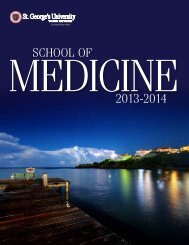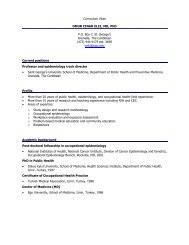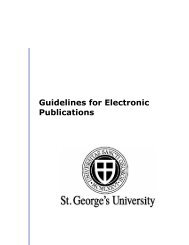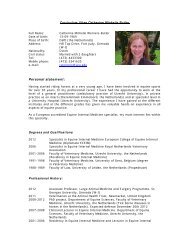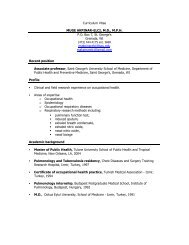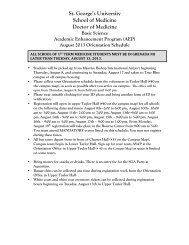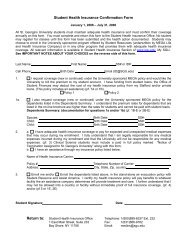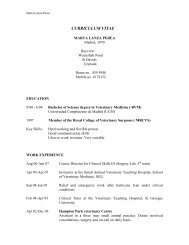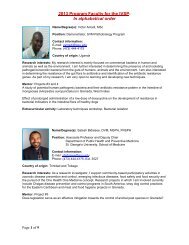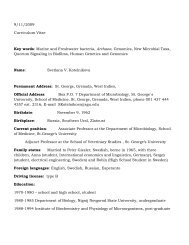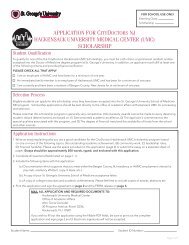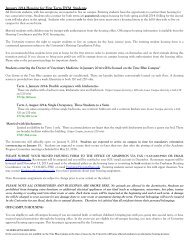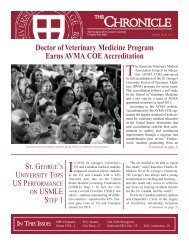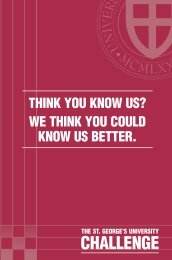ENGLISH PLACEMENT TEST - St. George's University
ENGLISH PLACEMENT TEST - St. George's University
ENGLISH PLACEMENT TEST - St. George's University
You also want an ePaper? Increase the reach of your titles
YUMPU automatically turns print PDFs into web optimized ePapers that Google loves.
<strong>PLACEMENT</strong> EXAM - <strong>ENGLISH</strong><br />
ST. GEORGE’S UNIVERSITY<br />
Exam time: one and half hours<br />
Section 1<br />
A. <strong>ENGLISH</strong> USAGE ITEMS<br />
DIRECTIONS<br />
Some of the following sentences contain an error in grammar, usage, or punctuation. Some of the<br />
sentences are correct. No sentence contains more than one error. If there is an error, select the one<br />
underlined part that must be changed in order to make the sentence correct and shade the corresponding<br />
space on your answer sheet. Assume that all other parts of the sentence are acceptable and cannot be<br />
changed. If there is no error, mark the final answer space, E. You have 20 (twenty) minutes to do this<br />
section.<br />
1. Cheryl is afraid of the thunder, she likes<br />
A B C D<br />
rain. No error<br />
E<br />
2. Jerry who had just eaten, thought concerning<br />
A<br />
B<br />
having a chocolate or ice cream. No error<br />
C D E<br />
3. The public is not so angry about the lack of jobs<br />
A B<br />
than it is disgusted with corruption in government.<br />
C D<br />
No error<br />
E<br />
4. While reading the assignment, the teacher suspect<br />
A<br />
B<br />
that the student had plagiarised and not documented<br />
C<br />
D<br />
carefully. No error<br />
E<br />
5. How well the new comedy series on GBN does in<br />
A<br />
the ratings depends almost entirely on its competition.<br />
B C D<br />
No error<br />
E<br />
1
6. Carrie and me were left a legacy by an uncle<br />
A<br />
B<br />
who had always liked us both. No error<br />
C D E<br />
7. I had read one of the most interesting book<br />
A<br />
B<br />
in the library before becoming a member.<br />
C<br />
D<br />
No error<br />
E<br />
8. Having enjoyed the scenery, the boat next took us<br />
A<br />
to Turtle Island, an island whose history was hardly<br />
B C D<br />
known until 1965. No error<br />
E<br />
9. The three-week Caribbean cruise will allow<br />
A<br />
B<br />
passengers to relax, to find romance and<br />
C<br />
and they can visit exotic places. No error<br />
D<br />
E<br />
10. There is a great many people in Grenada<br />
A B<br />
who have enough training to work easily<br />
C D<br />
with computers. No error<br />
E<br />
B. SENTENCE CORRECTION<br />
This is a test of correctness and effectiveness of expression. In each of the sentences of this section, one<br />
portion is underlined. Beneath each sentence, you will find five ways of writing the underlined part; the<br />
first of these always repeats the original and the other four are all different. If you think the original<br />
sentence is better than any of the suggested changes, choose the first answer A; otherwise, select the best<br />
revision and shade the corresponding space on your answer sheet. Do not make a choice that changes the<br />
original sentence.<br />
1. Heavy drinking and to overeat are activities which a heart patient must avoid.<br />
a. Heavy drinking and to overeat.<br />
b. Drinking heavily and to overeat.<br />
c. To drink heavily and overeating.<br />
d. Heavy drinking and overeating<br />
e. Drinking heavy and to overeat.<br />
2
2. In the small town of Gouyave, where one can easily find fish and other sea foods.<br />
a. , where one can easily find fish and other sea foods.<br />
b. where one can easily find fish and other sea foods.<br />
c. , where one can easily find fish and other sea foods,<br />
d. , one can easily find fish and other sea foods.<br />
e. one can, easily find fish and other sea foods.<br />
3. Dr. Johnson is a remarkable physical specimen: although sixty five, he is as vigorous as ever.<br />
a. although sixty-five, he is as vigorous as ever.<br />
b. he, seeing he is sixty five, is as vigorous as ever.<br />
c. he is sixty five, being vigorous as ever.<br />
d. as vigorous as ever, he is sixty five years of age.<br />
e. he is as vigorous as ever, however he is sixty five.<br />
4. Ms. Pierce’s recommendation was believed to be sufficient and that it would guarantee my getting a<br />
job.<br />
a. and that it would guarantee my getting a job.<br />
b. , and that it would guarantee my getting a job.<br />
c. and, that it would guarantee me to get a job.<br />
d. that it would guarantee me getting a job.<br />
e. to guarantee my getting a job.<br />
5. It was interesting to note that the prisoner’s hero was without moral convictions, acceptable manners,<br />
and he had little else in his favour.<br />
a. without moral convictions, acceptable manners, and he had little else in his favour.<br />
b. without moral convictions or acceptable manners and had little else in his favour.<br />
c. without moral convictions acceptable manners or little else in his favour.<br />
d. without moral convictions and acceptable manners or little else in his favour.<br />
e. without much else in his favour, including moral convictions and acceptable<br />
manners.<br />
6. One method of ending cheating in college is to demand references by all students.<br />
a. to demand references by all students.<br />
b. demanding students to give references.<br />
c. to demand that students give references.<br />
d. that students be demanded to give references.<br />
e. that of demanding students to give references.<br />
7. Mr. Vincent planning to teach a course in “Domestic Violence” next semester.<br />
a. planning<br />
b. are planning<br />
c. , with a plan<br />
d. was planned<br />
e. plans<br />
3
8. Being a tall person, the low ceiling was a problem to me.<br />
a. the low ceiling was a problem to me.<br />
b. I had a problem with the low ceiling.<br />
c. being a low ceiling was a problem for me.<br />
d. it was a problem for me.<br />
e. it was a low ceiling problem to me.<br />
9. Although both brothers are playwrights, one writing comedy while the other goes in for tragedy.<br />
a. one writing comedy while the other goes in for tragedy.<br />
b. one, writing comedy while the other writes tragedy.<br />
c. one writes comedy, the other doing tragedy.<br />
d. one writes comedy while the other writes tragedy.<br />
e. one writing comedy, the other writing tragedy.<br />
10. Neither the faculty nor the students was aware about exactly the kind of changes being made at the<br />
school.<br />
a. was aware about exactly the kind of changes.<br />
b. were aware about exactly the kind of changes.<br />
c. was aware of the exact nature of the changes.<br />
d. were aware of exactly what were the nature of the changes.<br />
e. was aware about the nature of the kind of changes.<br />
End of Section 1<br />
4
SECTION 2<br />
READING COMPREHENSION<br />
Read the passage below and then choose the best answer to the question. You have 40 (forty)<br />
minutes to answer this section.<br />
The fairy tale of Cinderella is one of the most widely known folk stories in the world. In its<br />
various versions it captures the struggle for the young girl’s passage into womanhood. It covers,<br />
in its scope, several of Karen Horney’s ideas, as well as the trials, totems, and family patterns<br />
found in primitive cultures. The Cinderella story chronicles the transformation of the girl into the<br />
woman, the profane into the spiritual; ending in the heroine’s resolution of her feminine powers.<br />
The Cinderella story goes back as far as seventh century China. It is classified among the most<br />
well-known folktales in the world, and there is a version in nearly every language. The plot is<br />
universal: Cinderella, a beautiful, kind, and loving girl, suffers within her family, and is aided by<br />
some form of magic, through which she meets the man she is destined to marry. After the initial<br />
meetings with this man, she loses some article symbolic of her womb, and the man uses this<br />
article to find and betroth her.<br />
Several of Karen Horney’s theories from ‘The Distrust Between the Sexes’ are evident in this<br />
folktale. One of the main ideas in Cinderella is the concept of the evil stepmother or foster<br />
mother. Even in instances where Cinderella’s father is still living, the stepmother is allowed to<br />
abuse her. Her elder sisters are also given this privilege. This is because the mother and sisters<br />
are older and less attractive than the heroine. Cinderella’s persecution is permitted because, as<br />
Horney says, “… it is only the sexually attractive woman of whom [man] is afraid and who …<br />
has to be kept in bandage.” In the cultures from which the story derives, old women are not<br />
sexually threatening to men and so the stepmother is given the power (by the father) to make the<br />
heroine submissive. Horney continues: “Old women, on the other hand, are held in high esteem,<br />
even by cultures in which the young woman is dreaded and therefore suppressed.” Not only is<br />
the stepmother granted more power over Cinderella due to her position, but she feels her power<br />
potentially jeopardized by the sway that Cinderella’s beauty may have over men. The sisters also<br />
feel jeopardized by the heroine’s sexual attractiveness, which leads to greater resentment and<br />
cruelty on their part.<br />
Another of Horney’s theories prevalent in the story is the duality of motherhood. There are two<br />
aspects of motherhood, the virgin mother who is self-sacrificing, nurturing and selfless, and the<br />
mother goddess, warm, earthy, sensual, and fertile. Both aspects are visible in the heroine.<br />
Cinderella, as she is first seen, sleeps in the cold, empty hearth, reflective of the virgin’s womb,<br />
empty until acted upon by some outside force. She is covered in ashes, dressed in rags; in general<br />
a picture of self effacing humility. Despite the hardships put upon her by her family, she is kind<br />
to them and even tries her best to beautify her step sisters for the ball. She is virtuous, in contrast<br />
to her stepsisters and stepmother. After marriage to the prince, in the end, the heroine does not<br />
5
seek any revenge on her persecutors. In some renditions, she actually invites her family to come<br />
live with her and her new husband. Further evidence of this virginal mother aspect is the part that<br />
the prince plays in her life at this point. Like the ultimate example of nurturing motherhood,<br />
Mother Mary, who waits for the male god to act upon her, Cinderella lies in wait for the prince to<br />
come and save her. He is the aid she needs to be freed of her harsh life.<br />
The other aspect of motherhood is revealed in her when magic help arrives from the outside. She<br />
is bestowed with sensual, material things: beautiful clothes, ornaments, cosmetics: things to make<br />
her desirable to men. The heroine is also gifted with the famous shoes, reflective of the womb.<br />
The prince is usually attracted to her for her physical appearance. She is displaying her sensual,<br />
seductive, earthy side and the prince is a reward for her power to act on him with her seductive<br />
ability. This dichotomy provides some confusion to the heroine, her family, and her suitor. The<br />
journey to resolve the puzzle of her two-fold womanhood is a main theme in this folktale.<br />
The passage from a girl to a woman is only one of the several transitions that take place within<br />
our heroine. She also undergoes a spiritual transformation. In the beginning of every account,<br />
the heroine is dirty and ragged. In at least three versions, she is made to wear animal skins.<br />
These things are representative of the material, animalistic, profane world. As she is put through<br />
the trials for entering into adulthood, she is also put through trials to test her spirituality. In spite<br />
of hardships, she manages to remain pious, loving and kind. These trials come to an end and she<br />
becomes clean and well dressed. She is described as radiant, angelic, and fairylike. The heroine<br />
is then presented to the prince. The image of the prince embracing the servant girl is heavily<br />
laden with religious meaning, especially during the period when this story became popular. This<br />
analogy was very often used by the convents of the Middle Ages to relate the relationship of the<br />
nuns to Jesus Christ. Cinderella’s spiritual ascent is completed with her royal wedding.<br />
The heroine’s time of testing is not completely at an end until the two sides of her femininity<br />
merge. They have been in the process of merging since the time of her totem’s arrival. Since the<br />
arrival of the totem, she has actively struggled with her two female aspects, the virginal/nurturing<br />
and the earthy/seductive. The heroine in each version of the tale is given a womb symbol: either<br />
a shoe or a ring. This symbol accompanies her when she meets the prince in her state of beauty<br />
and sensuality. She then loses this article with the prince, who uses it to find her. When he sees<br />
her again, she is once more virginal, modest, covered in dirt ashes, yet she is missing this symbol<br />
of her womanhood. The prince is confused; this is not quite the girl he thought he came for.<br />
After he places the shoe on her foot (or the ring on her finger, as the case may be) he sees her as<br />
whole: sensual, earthy, yet loving and virginal. She no longer runs from him as she did in earlier<br />
encounters, when things became too intimate with the prince.<br />
This is also a moment of recognition for Cinderella. She has discovered a unity of both female<br />
forces within her. There were clues previously as to the wholeness of her nature, but she ignored<br />
them. She managed to overlook the times when she was sensual, at the ball, and was still kind to<br />
her family, generously giving them jewellery. She failed to see her true nature when she was<br />
beautiful and yet very humble in the presence of nobility. Now she can no longer hide herself.<br />
The prince has seen her spiritual, virginal, and sensual facets and her true nature is revealed to all,<br />
including her astonished family. She found strength in wholeness, and the prince is both her aid<br />
in discovering herself and her reward for being discovered.<br />
1. This passage asserts that:<br />
I. only those versions of the story that are American can be used to illustrate<br />
Horney’s theories.<br />
6
II. regardless of the version of the Cinderella tale, the story tells of a young girl’s<br />
passage into womanhood.<br />
III. the concept of the evil stepmother or foster mother is a main ingredient in the<br />
Cinderella story.<br />
IV. Cinderella’s sisters typically are older than she and less attractive.<br />
V. the prince finally sees only one facet of Cinderella.<br />
a. I, II, and III c. II, III, and IV<br />
b. I and IV d. IV only<br />
2. According to this passage, Cinderella:<br />
a. contemplates revenge on her sisters and mother but doesn’t carry through with it.<br />
b. does not seek revenge at all.<br />
c. gives up her need for revenge after she marries the prince.<br />
d. cannot bring herself to completely forgive her persecutors.<br />
3. The author of this passage concludes the following from the fact that in at least three versions of<br />
the story, Cinderella is made to wear animal skins.<br />
a. She needs the warmth that these skins provide.<br />
b. The animal skins have nothing to do with the rites of passage that she is going through.<br />
c. The animal skins symbolise the profane animal world that she figuratively is leaving.<br />
d. She may decide to keep the animal skins.<br />
4. Throughout the essay, but especially in the concluding paragraphs, the author suggests that<br />
Cinderella:<br />
a. is less complex than she had originally thought herself to be.<br />
b. is moving psychologically toward a condition of wholeness.<br />
c. intentionally exploits the prince to bring about her own growth.<br />
d. is weakened by her newly discovered wholeness.<br />
5. One might draw the following conclusions from this passage:<br />
a. Horney probably had the Cinderella story in mind when she formulated her theories.<br />
b. Folktales and fairy tales such as Cinderella can be useful in illustrating aspects of<br />
psychological theories such as those of Horney.<br />
c. Horney’s theories are valid because the plots of the various versions of the Cinderella<br />
story bear them out.<br />
d. Horney altered the story to make it fit her theories.<br />
6. An appropriate title for this essay would be:<br />
a. “If the Shoe Fits”: Horney’s Theories and the Cinderella <strong>St</strong>ory.<br />
b. The Narcissism of Cinderella.<br />
c. The <strong>St</strong>epmother as Heroine.<br />
d. The Varieties of Magical Experience: the Shoe that Fit.<br />
7. If one were to write an essay that used logic similar to that in this essay, that study might be<br />
called:<br />
7
a. Fairy Tales of the Western World.<br />
b. Jack and the Beanstalk and the Theories of Sigmund Freud.<br />
c. Little Red Riding Hood and Snow White.<br />
d. Cinematic Interpretations of Eastern and Western Folktales.<br />
8. In its context, the word “chronicles” (line 7) means most nearly<br />
a. captures<br />
b. researches<br />
c. testifies<br />
d. heralds<br />
9. The word “it” in Sentence 2 refers to which of the following:<br />
a. Folk stories of the world.<br />
b. The trials and family patterns of primitive cultures.<br />
c. The fairy tale of Cinderella.<br />
d. A young girl’s transformation to womanhood.<br />
10. Which sentence best summarizes Paragraph 6<br />
a. The Cinderella story is also symbolic of spiritual transition.<br />
b. Cinderella experienced several transitions.<br />
c. The story is best understood in its historical context.<br />
d. The story was probably created by monks in the Middle Ages.<br />
End of Section 2<br />
8
SECTION 3<br />
THE WRITTEN ESSAY<br />
In a 100 – 150 word essay, respond to the following topic. You have thirty (30) minutes to plan,<br />
write and proofread your essay.<br />
A. Television does more harm than good. Write a speech in which you present strong<br />
arguments for or against this view.<br />
End of Examination<br />
9



